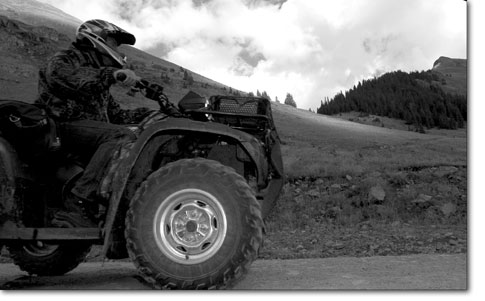|
|
||
|
Getting a grip on ORVs
With off road vehicle use and subsequent impacts at an all-time high, residents of the San Juan Mountains have begun to mobilize efforts to stem damage to the areas backcountry. Squeezed shoulder to shoulder in the San Juan County Courthouse last week, concerned citizens from three counties gathered for an end-of-year meeting with the Bureau of Land Management. The subject of the evening was ORVs, their increased use in the backcountry of the San Juans and the increase in damage to the regions fragile ecosystem. Members of the Silverton Mountain School, a local quiet use club of more than 100 members, lead the group in calling for action from San Juan County, the BLM and Forest Service to enforce proper usage of the motorized vehicles. The Silverton Mountain School and the Animas River Stakeholders Group both presented several photos of damaged areas in the San Juans. Examples included tire tracks leading across wildflower meadows, mine remediation sites destroyed by muddy ruts, and one photo in particular that showed tire tracks leading across a meadow from a large bag of garbage that had been left by ORV users. The general consensus that I hear is that they feel they can do anything they want, said Charlie Schmalz, a volunteer at the Silverton Public Lands Center. Its like they know there isn't enough law enforcement out there. BLM Ranger Scott Jackson, who gave a report on ORV impacts in the area, said ORV traffic continues to increase each year and admitted that many of the management tactics that used to work are no longer effective. Boulders placed to create barriers around protected areas are being moved, signs are driven around, and berms are driven over. The challenge in coming seasons will be to find better ways to manage users, he said, stressing that education likely will be the answer to the problem. Jacksons partner in the field, Lisa Richardson, said there also are concerns about small children being allowed to operate the vehicles without supervision. We aren't like Moab or Rifle where there are designated trails for riders, she said. We have real dangers because of where we are, plus there is the traffic on our county roads. Many said that problems crop up as a result of inconsistent laws. Licensed ORVs are allowed to travel county roads in the three-county region of Hinsdale, San Juan and Ouray counties. But, they are not allowed on state highways or in the city limits of Silverton, Ouray or Lake City, towns on the popular Alpine Loop Backcountry Byway. In addition, there is inconsistency among the laws of federal, state and county jurisdictions, and there is also inconsistency in reciprocity with out-of-state regulations. We see a lack of consistency from county to county, said San Juan County Sheriff Sue Kurtz. And the federal laws are different from the county laws. If rides start in one county, the laws may change when the riders move into the next county. And state-to-state licensing laws also seem to add a great deal of confusion. For example if ORVs are licensed for highway use in Arizona, does the State of Colorado acknowledge that license? According to Kurtz, San Juan County follows Colorado State Patrol guidelines on this law and does not grant reciprocity to out-of-state licensed ORVs. However, other Colorado counties vary on the law. All law enforcement officials attending the meeting agreed that laws would need to be consistent before any type of real enforcement could go into effect for future seasons. Kurtz also recommended that counties hire a summer enforcement authority of some kind. Currently there is one BLM law enforcement officer for the entire region, allowing for many operators illegally using federal lands to go uncited. Keith McGrath, of BLM Law Enforcement, agreed with Kurtz on the need for uniformity, saying, Ill be glad to sit with the officials from all three counties and see what their needs are. Once we have an agreement, we can see about arranging for supplemental rules that will allow for enforcement reflecting what the counties want to do. But the big question still remaining was how to patrol such a large area. "What are you going to do?" demanded John Dourlet of the San Juan Trail Riders, a local ORV group. I say let the ATV community patrol the ATV community. Where else are you going to get the manpower? The feds arent going to give it to you. Dourlets idea for one ATV volunteer per day to patrol the region and report infractions to BLM officials was stayed by Jackson, who pointed out that most infractions are already reported by backcountry users. Dourlet also claimed that local riders are rarely to blame for backcountry damage and that he was at the meeting to help protect the regions resources as well as his right to ride. Who is causing the damage, however, became secondary to the fact that it is happening in overwhelming measures. All parties acknowledged that typically, organized riders do not cause the damage to the backcountry. Those groups educate themselves and help patrol and educate others. Often it appears to be individuals or families traveling in groups that disregard the laws. In an attempt to be proactive a few years back, the three counties published an informational flyer of laws, safety measures, phone numbers and a map for ATV users. But thus far, according to those attending the meeting, such efforts have fallen short, and increased enforcement seems to be the next solution. Dourlet later praised the dialogue that developed during the meeting. This is usually a forum for finger pointing, he said. But this was a meeting where solutions to the problem were discussed. The meeting ended with all parties agreeing that the next step is a collective meeting between the three counties officials and BLM officials to set standards for ATV use in the tri-county area. |


